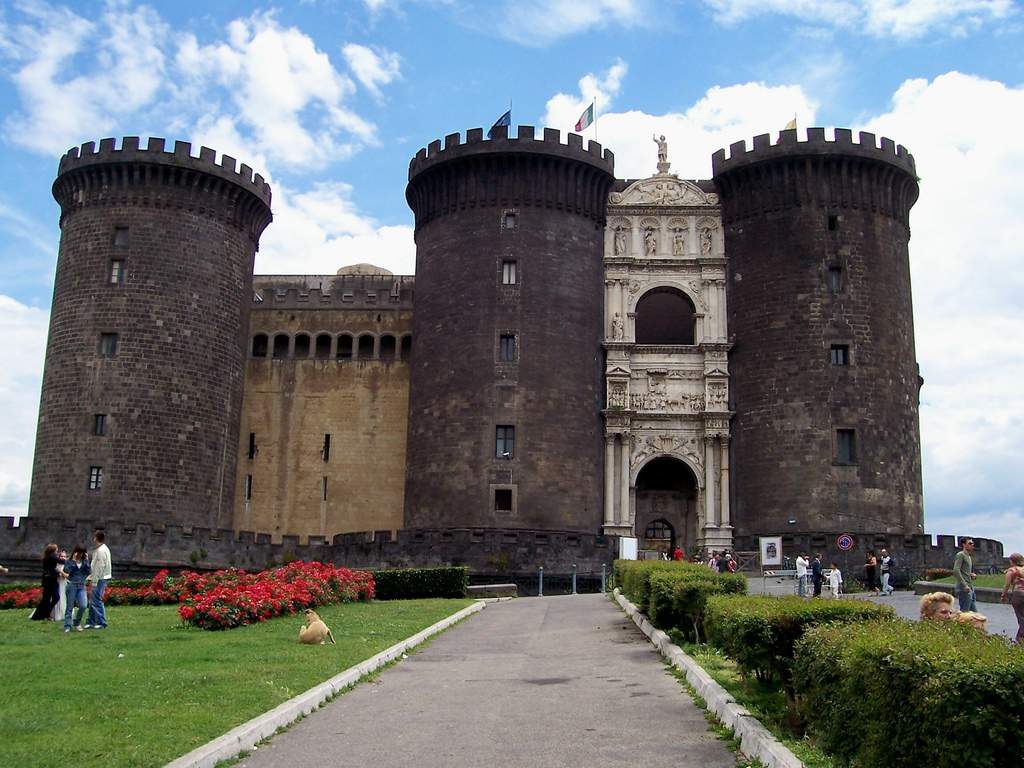Naples, abandoned art treasure found in the basement of the Maschio Angioino
In Naples, in the basement of the Maschio Angioino (Castel Nuovo), a precious treasure trove of many works of art has been found (even “countless” according to the city council, about 400 according to local press reports), from various periods, from the 15th to the 20th century: there is also a large Madonna of the Rosary with Dominican saints by Luca Giordano (measuring 4 meters by 2.64), and then works by artists such as Francesco De Mura, Paolo De Matteis, Giuseppe Bonito, Onofrio Avellino, Jacopo Cestaro and other important painters and sculptors from the area. The discovery came about in a completely fortuitous way: the works in fact “resurfaced” on December 1, when City of Naples officials went to the rooms that housed the works to check, following a strong wave of bad weather that had hit the city in the previous hours, whether there had been flooding in the premises. The technicians discovered the works, left to their own devices, some of them deteriorated due to the dampness of the premises-they have allegedly been there for decades.
The news spread because on April 23 the Naples City Council met precisely to discuss this case. “The Municipality of Naples,” the council resolution reads, “holds a considerable heritage of movable property of artistic value, dating from Greco-Roman antiquity (Santangelo Collection at the National Archaeological Museum in Naples) to the present day, constituted through purchases, donations and as a result of Regional Law no. 65 of Nov. 11, 1980 by which the city’s ecclesiastical buildings belonging to the so-called ’suppressed entities,’ i.e., IPABs, Institutes for Assistance and Beneficence (such as the Real Casa dell’Annunziata, the Albergo dei Poveri, the Sant’Eligio Institute for Education and Female Education, etc.), together with their considerable patrimonial holdings of works of art (paintings, sculptures, silver, furnishings, etc.), passed to the legal jurisdiction of the Municipal Administration.”
The hypothesis is that these are precisely the works of the IPABs that were sheltered in the Maschio Angioino after the 1980 Irpinia earthquake, which also damaged several buildings in Naples. These included the buildings of the Istituti per l’Assistenza e la Beneficenza, which housed numerous works of art: so, in order to save them, they were relocated to different locations (some went to the Royal Palace, others to Capodimonte and several other temporary storage facilities). Some ended up at the Maschio Angioino, and now therefore the newly found works are thought to be precisely those transferred after the Irpinia earthquake. The works were examined during an inspection with the mayor, Luigi de Magistris, and the superintendent of Naples, Luigi La Rocca.
Given the state in which these works are found, the resolution reads, “maintenance and restoration work on the artistic assets, particularly paintings, assets most subject to deterioration, is urgently needed to ensure their preservation and subsequent museum use, enriching the collections of the Civic Museum of Castel Nuovo, expanding its cultural offerings and allowing citizens, visitors, and scholars in the field to discover an artistic heritage that has been neglected and denied for too many decades.” The City Council has reportedly already proposed a three-phase project: the securing up to the glazing of the works with the drafting of conservation sheets (50,000 euros), the conservative restoration of Luca Giordano’s Madonna of the Rosary and another large work to be selected among those of greater value and musealization of the same works (50,000 euros), and the restoration of other valuable and valuable paintings such as those by De Mura, De Matteis, Cestaro Bonito, Giacinto Diano, and Agostino Beltrano (150,000 euros). The plan, therefore, is to make sure that the public will be able to see the works again.
Margherita Del Sesto, a Campania-based deputy of the MoVimento 5 Stelle in the Culture Committee, also spoke on the matter and intends to bring the case to Parliament. “It is strange,” she says, “that the news has found diffusion only a few hours ago, following the publication of a resolution of the City Council containing summary information about the discovery. I will soon file a question to Minister Franceschini to shed light on the matter. If after the 1980 earthquake, when those works of art are presumed to have been taken from many former IPAB (Istituti Pubblici di Assistenza e Beneficenza) buildings, no inventory was prepared there is a risk that theft or dispersion may have occurred. It is important and urgent to shed light on possible responsibilities and put in place timely interventions: that heritage of great value must be immediately secured, safeguarded and restored, with a view to a hoped-for public display.”
In the photo: the Maschio Angioino. Ph. Phil Tizzani
 |
| Naples, abandoned art treasure found in the basement of the Maschio Angioino |
Warning: the translation into English of the original Italian article was created using automatic tools. We undertake to review all articles, but we do not guarantee the total absence of inaccuracies in the translation due to the program. You can find the original by clicking on the ITA button. If you find any mistake,please contact us.





























